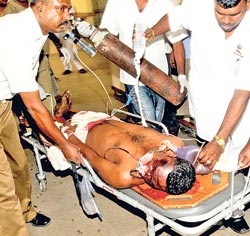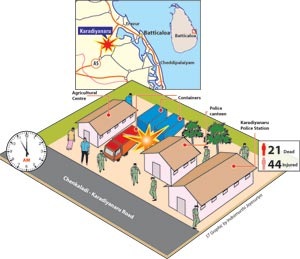Official version of ‘accident’ comes under scrutiny as negligence cannot be ruled out
Report by Leon Berenger and Chris Kamalendran In Karadiyanaru, Batticaloa. Pix by J. Weerasekera
It was close to noon on Friday when 25-year-old A. H. M. Riyaz, a clerk at the Karadiyanaru Agrarian Centre, located on the Batticaloa-Badulla A5 road, witnessed the ceiling of his office fall on him. While Mr. Riyaz was fortunate to be alive, sharing his story with the Sunday Times, there were 21 others present at places surrounding the Agrarian Centre, who were not as lucky.
On that sweltering day, according to police reports, three trucks packed with dynamites accidentally exploded in Karadiyanaru, 26 kilometres west of Batticaloa town, leaving 21 dead and close to 50 injured. It was also the first major explosives blast in Sri Lanka after the end of the civil war last year.
While the Ministry of Defence in Colombo was quick to rule out sabotage, President Mahinda Rajapaksa ordered an inquiry into the incident. The Army too would conduct its own investigations. A report from the Army’s Division 23 (supervising the area) is expected to be submitted to Defence Secretary Gotabaya Rajapaksa by the middle of next week.
 Immediately after the blast, the Sunday Times team travelled via the Badulla-Chenkaladi Road in the outskirts of the Batticaloa town, passing vast tracts of paddy land and remote villages. The road was under construction at several pockets as bridges and culverts that had existed earlier had been destroyed in the civil war.
Immediately after the blast, the Sunday Times team travelled via the Badulla-Chenkaladi Road in the outskirts of the Batticaloa town, passing vast tracts of paddy land and remote villages. The road was under construction at several pockets as bridges and culverts that had existed earlier had been destroyed in the civil war.
On reaching Karadiyanaru, the team’s initial view of the site was not an unfamiliar one. The police station located there had been blown to bits and vehicles burnt to cinders as if a bomb had ripped through that stretch of road. Thick iron debris was flung a thousand metres from the blast site to surrounding areas.
The place swarmed with heavily armed police personnel, commandos of the Special Task Force (STF) whose abandoned building in the vicinity had also been blown away. The Army had sent two companies of its personnel along with 200 packets of essential items such as food and water for the victims of the blast.
Assistant Police Superintendent (ASP) Vijitha Karunakala told the Sunday Times that he had heard the explosion at his office situated some kilometers away from the blast scene. “I summoned a party and immediately rushed to the scene and helped to rush the dead and injured to the nearby hospitals. It was a frightening site and it reminded me of the earlier days during the war,” he said.
The explosion took place at a time when another resident of that area, A. Baskaran, was parking his motor cycle under a mango tree and entering the Karadiyanaru Agrarian Centre clutching several files. As a technical officer attached to the Eastern University, he was on that day, supposed to interview prospective beneficiaries of the government’s subsidized agriculture fertilizer.
“It happened without a warning. There was a loud explosion, and the whole place was engulfed in black smoke. Parts of the roof of the building began to cave in as I made a desperate dash for the front door,” Mr. Baskaran said, adding that he had been hit on the leg by certain objects which immobilized him. Later he was taken to the Karadiyanaru hospital and subsequently transferred to Batticaloa hospital for treatment.
 Subramanium Isravel, 56, operated a cycle repair shop in the vicinity of blast site. On Friday, he had gone to the police station to get some repaire work when the blast occurred. “All I heard was a deafening explosion that forced me to the floor. I pleaded for help, but nobody was there to help. I later found out that almost every one was dead,” he said. Mr. Isravel was hit in the chest and arms by flying debris, he added while receiving treatment at the Batticaloa Hospital.
Subramanium Isravel, 56, operated a cycle repair shop in the vicinity of blast site. On Friday, he had gone to the police station to get some repaire work when the blast occurred. “All I heard was a deafening explosion that forced me to the floor. I pleaded for help, but nobody was there to help. I later found out that almost every one was dead,” he said. Mr. Isravel was hit in the chest and arms by flying debris, he added while receiving treatment at the Batticaloa Hospital.
At the hospital, the Sunday Times team also met Lahiru Prasad Jayasinghe a 24-year-old police constable from Dehiattakandiya, attached to the police mobile service. He was wounded in the head and chest and was among the only two police personnel to survie the blast at the station. Twelve of his colleagues were killed.
According to Dr. Kandasamay Muruganandan, director, Batticaloa Hospital, most of the injured had suffered serious fractures to their limbs but their conditions were not life-threatening. He also said that while having to cope with this emergency situation, the hospital ran short of essential drugs such as pain-killers.
“In the past during the conflict we used to maintain reserve stocks owing to the fighting and situation at that time, but we never expected something like this to happen during peace time,” Dr Muruganandan said.
His hospital had received nine dead including six policemen and three civilians along with 44 injured people. There were 35 men and nine women, among the injured. According to him, civilians caught in the explosion were the fertilizer beneficiaries who at that time were visiting the Agrarian Centre.
While investigators remain tight-lipped, the question of how the blast was triggered remained unanswered till yesterday. A few residents of the area told the Sunday Times team that two Chinese project managers and three Sri Lankan labourers usually went to the trucks of dynamites parked outside the Karadiyanaru police station every day to get their supplies of the required amount of explosives for a nearby stone quarry. Stones from the quarry were being used to reconstruct stretches of the road along which the police station was located.
onstructing roads and bridges in this war-torn district for the past one year or so. During the past year, the practice had been to keep truck loads of dynamite at the premises of the police station, to ensure safety and security of the explosives.
The area police chief Senior Deputy Inspector General (SDIG) Edisson Gunatilleke told the Sunday Times that it was too early to come to any conclusion until the Government analysts come up with their report.
“However there is one thing very clear. There is no sabotage involved in the issue although there may be a certain degree of negligence that led to this tragic incident, DIG Gunatilleke added.
Furthermore he said the police station was to be shifted to an abandoned STF camp situated some 300 metres up the road before this happened. “An investigation will nonetheless be carried out with out delay,” DIG Gunatilleke added.
However, either no one knows or no one is really saying what went wrong with the explosives on that particular day. The official explanation so far is that it seemed like an accident. But could negligence be ruled out?
Was it negligence on the part of the Chinese company or the police and local authorities to store such explosives close to a building frequented by the public? The accountability will soon need to be fixed.
Karadiyanaru OIC one of the lucky ones
The Officer in Charge of the Karadiyanaru Police station inspector M.A. Bandulasena and over 30 other policemen narrowly escaped the blast as they were on duty outside the station.
(For updates you can share with your friends, follow TNN on Facebook and Twitter )
